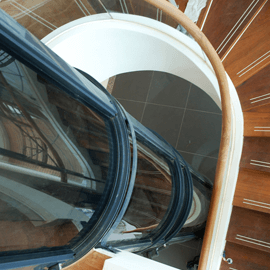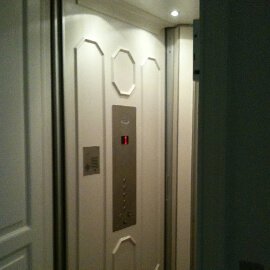Elevator Safety
 When getting a residential elevator installed into your home, it is important to follow code to make sure it is safe for passengers. By following the elevator codes of your state, you can be confident that your residential elevator is safe. When purchasing a residential elevator from us at Nationwide Lifts, we recommend the installer follow the current safety codes for your state.
When getting a residential elevator installed into your home, it is important to follow code to make sure it is safe for passengers. By following the elevator codes of your state, you can be confident that your residential elevator is safe. When purchasing a residential elevator from us at Nationwide Lifts, we recommend the installer follow the current safety codes for your state.
Elevator Safety Codes Should Be Followed
Most states follow codes that are specified by ASME A17.1. Both residential and commercialelevators should follow these codes to create the safest environment for people using them. The codes deal with everything from creating the machine room to proper lighting.
In the area of the hoist way, or elevator shaft, the jambs need to be wrapped over 1/16 of an inch for labeling purposes. The area around the elevator car should have beam projections of no more than two inches and setbacks need to be leveled or covered. The space between the elevator car and the elevator shaft, also known as the running clearance, needs to be at least ยพ of an inch. There can be no recesses allowed in the elevator shaft for any elevator and if the shaft extends more than two floors, a vent needs to be put it.
Elevator Code

When getting a residential elevator installed into your home, it must follow a specific set of codes.
While some states may have their own codes, many states require you to follow the codes specified by ASME A17.1. Whether you are purchasing or installing a residential elevator, make sure the installation follows code to avoid injury to passengers.
Does Your Installation Require A Machine Room?
If the elevator to be installed requires a machine room, the door size must be at least 30 by 72 inches. Inside of the room, there should be no foreign wiring or piping. The room should also be on the same side as an earthquake joint if you should live in an area near fault lines. The room needs to be ventilated, whether it is natural or from mechanical means. The door leading to the machine room must be tagged with a fire rating, which should be equal to that of the hoist way. In the event of an emergency such as a fire, the switch, clearance, and equipment numbering more than two should be disconnected.
Guidelines to Follow in Regards to Lighting
There are also guidelines that need be followed in regards to lighting.
- The machine room needs to be properly lighted for safety purposes.
- The light switch must be located within 18 inches of the lock side of the door.
- Any actual lights in the room should be at floor level, and if any lights are placed within eight feet above the floor, they need to be protected with a light guard.
Have Your Machine Room Up To Code
There are also a few safety devices that the machine room needs to be fitted with to have it up to code. The machine room, for both residential and commercial elevators, needs to have a class ABC fire extinguisher hung on the wall. You can either have a heat detector or a sprinkler with a connected flow with a head guard. To protect people in the machine room from electrical shock, the room should have a GFI outlet.
Protect Both Technicians and Elevator Passengers
The codes listed by ASME A17.1 are very important to protect the safety of both technicians and passengers. They are not, however, required by law. The codes are for both residential and commercial elevators but may differ by state. Commercial elevators will most likely have more codes than a residential elevator. At Nationwide Lifts, we recommend that you follow all elevator code requirements to have a residential elevator that is safe and can work to the best of its ability.
Machine Room & Elevator Shaft Safety
Both the machine room and the elevator shaft need emergency protection. There needs to be a sprinkler and smoke detector in case of a fire. If multiple elevators are present, each one needs to have its own sprinkler and smoke detector. The sprinkler can be replaced with a heat detector if that is your preference. A smoke and heat detector must be behind a locked access door with screening and have dimensions of two feet by two feet. If you do choose a sprinkler for the elevator shaft, it needs to be covered by a guard.
If the elevator requires a pit, it will need to follow many of the same codes that the elevator shaft does, such as a sprinkler with a covered head. The area needs to be lighted with the light switch being located 18 to 36 inches above the sill in the pit. The lights should be guarded and grounded, with a GFI outlet to prevent shocks. Lastly, there should be a drain installed in case a spill or leak occurs in the pit. The drain will prevent any accumulation of liquid in the pit.
Safety Features Of Elevator Types
While most systems are extremely safe, they still have back up elevator safety precautions. Hydraulic elevators are never suspended in the air, because they are always being held up by the hydraulic arm. A cable elevator is sometimes suspended in the air but normally has at least four steel cables attached to it. Each cable could hold the elevator car by itself, but in the unlikely event that they all break, emergency brakes will kick in, not allowing the car to descend.
Do You Need Insurance for Your Elevator?
 A residential elevator can be a wonderful addition to a home. New homes with multiple levels often come with elevators pre-installed, and elevators are also frequently installed in existing homes.
A residential elevator can be a wonderful addition to a home. New homes with multiple levels often come with elevators pre-installed, and elevators are also frequently installed in existing homes.
Homeowner's insurance frequently includes additional accessories like swimming pools, tennis courts, patios, and, in some cases, residential elevators. The first thing you should do is check to see if your home elevator is covered under existing terms.
New homes with residential elevators will most likely have their elevators insured.
If you are installing an elevator in an existing home, check whether your homeowner's insurance covers your elevator. If not, you will need liability insurance that covers injuries that may occur to anyone who uses it. It's similar to liability insurance for other vehicles, including your car.Not many people get injured in elevators, but the possibility exists, so liability insurance is important.
The most common incident where an injury can occur is if the elevator gets stuck and people are injured trying to get out. You would be liable for this kind of injury, so you need insurance in case that type of situation occurs.
You may also need elevator insurance to prevent damage to the building. Again this is most likely to occur if the elevator becomes stuck. As people try to get out, they can do damage to the building. It is possible that the fire department would have to tear out walls to get people out of the elevator. The cost of repairs would be significant, so you need insurance to cover it.
Another important consideration for elevator insurance is that the National Flood Insurance Program regulations require that elevators and their associated equipment be protected from flood damage. NFIP coverage is limited to elevator equipment, and there are restrictions on what equipment is covered.
At Nationwide Lifts, we pride ourselves in providing the safest elevators on the market. Our elevators are top of the line, and by adhering to regular maintenance, you can enjoy your residential elevator without any worry.
<< Back to Articles
